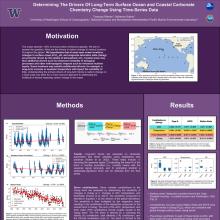Determining The Drivers Of Long-Term Coastal Carbonate Chemistry Change Using Time-Series Data
Treasure
Warren
University of Washington
Poster
The ocean is a sink for anthropogenic atmospheric CO2. This uptake of CO2 leads to a host of changes in the ocean carbonate system. The aim of this research is to identify the drivers of long-term carbon change at various locations throughout the global ocean. We hypothesize that at most open ocean locations, changes in surface ocean pCO2, pH, and aragonite saturation state (Ωaragonite) are primarily driven by the uptake of atmospheric CO2. Coastal areas may face additional drivers such as enhanced variability in biological processes and other anthropogenic impacts such as enhanced nutrient inputs. Some locations may exhibit multifaceted drivers; for example, a long-term increase in seawater temperature will impact the solubility of CO2. In this research, we evaluated the sensitivity of surface ocean pH and Ωaragonite changes to the drivers of salinity-normalized dissolved inorganic carbon (sDIC), temperature, and freshwater. Preliminary findings at most locations were consistent with this hypothesis in regards to Ωaragonite. Observational constraints of long-term drivers of change provide critical information for ocean acidification predictions and region-specific approaches to addressing changes to surface carbonate chemistry.

Poster file
warren-treasure-optimizing-poster.pdf
(3.74 MB)
